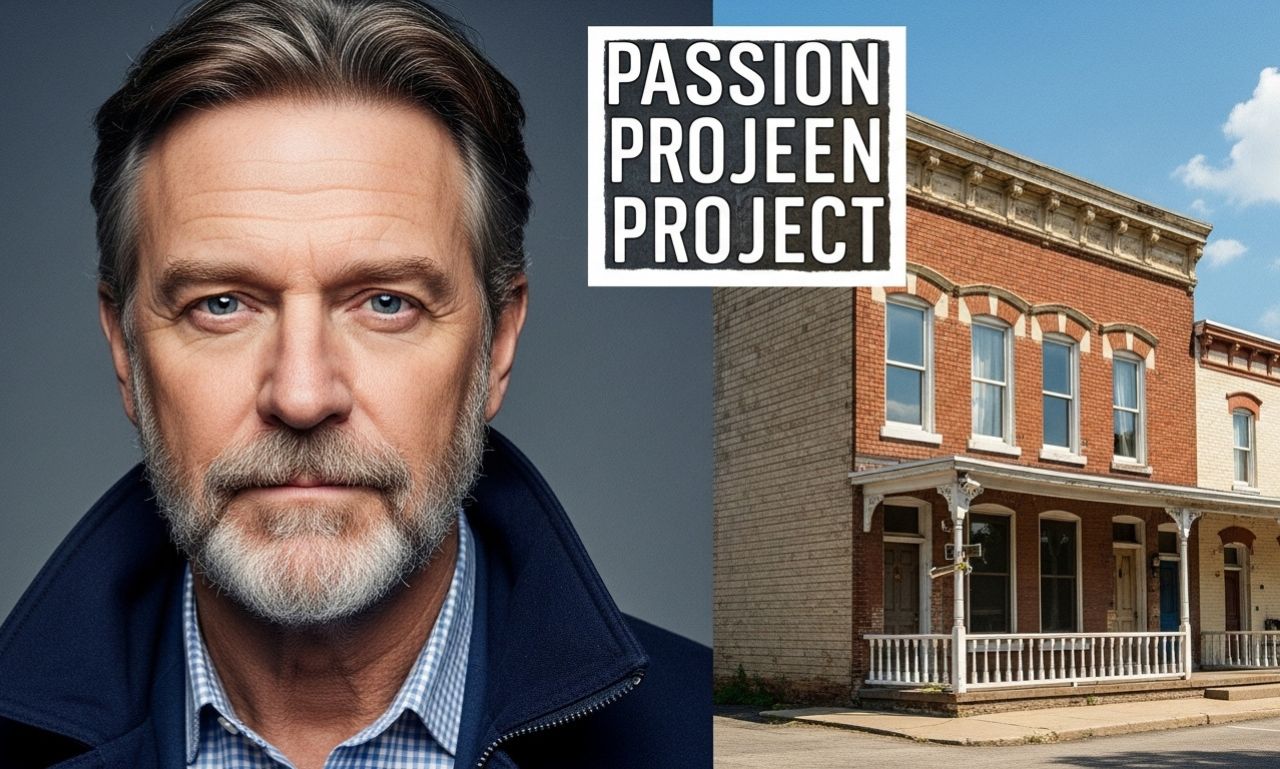When you hear the term Mike Wolfe passion project, you think of dusty barns, vintage motorcycles and a TV personality—but you’d be missing so much more. Mike Wolfe’s passion project is not just a side-hobby. It is a full-fledged mission to preserve heritage, restore small-town America, support craft makers, and tell the stories behind the objects and the buildings. In what follows we’ll dive deep into how Mike Wolfe’s passion project has evolved, what drives it, the impact it’s making, and how you—the reader—can take inspiration from it.
The Origins of the Mike Wolfe Passion Project
In his youth, Mike Wolfe spent time exploring barns, attics and roadside junk across the Midwest. That early curiosity gave rise to a career on the hit show American Pickers, where he hunted for forgotten relics. But then something shifted: the thrill of the find became less about profit and more about meaning. Thus, the Mike Wolfe passion project was born — a move from simply picking objects to preserving stories and places.
He recognised that objects and buildings carry the voices of the past—and that when they vanish, so do the stories. That realisation steered his work toward restoration of historic buildings, revitalising main streets, and re-imagining relics as living assets.
What the Mike Wolfe Passion Project Encompasses
This is no one-dimensional venture. The scope of Mike Wolfe’s passion project covers multiple interconnected elements:
-
Historic building restoration: Reviving old structures in small towns and giving them new life.
-
Antique and vintage object preservation: From gas-pumps to motorcycles, old signs to farm-tools — viewing them as cultural artifacts.
-
Small-town economic and cultural revitalisation: Using investment in heritage to draw foot traffic, build local pride and support artisans.
-
Storytelling and community engagement: Sharing the why and how of restoration, involving locals, and lifting up the makers.
-
Sustainability and craftsmanship: Emphasising reuse, quality, and the human touch in a world of disposables.
In short, Mike Wolfe’s passion project uses the past to inform the present and build a more rooted future.
Why the Mike Wolfe Passion Project Matters
In our fast-moving world, small towns and old buildings often get left behind or bulldozed in favour of the new. The Mike Wolfe passion project reminds us that heritage is more than nostalgia. It’s identity, it’s community, it’s potential.
For example: a dilapidated Main Street becomes a cultural hub. Abandoned storefronts become artisan spaces. Old tools become conversation starters. Through his work, Wolfe helps communities feel valued again, economies get new life, and heritage speaks to new generations.
It also encourages each of us to see value in what we might call “junk,” to ask why something was made, who made it, what happened to it, and how we might reuse instead of discard.
Notable Examples from the Mike Wolfe Passion Project
Let’s look at some concrete instances that illustrate how this vision plays out in real places:
-
In Columbia, Tennessee, Wolfe invested in historic downtown structures — once closed storefronts now renewed and buzzing.
-
Through his digital brand “Two Lanes,” Wolfe highlights small-town makers, shows restored buildings, and encourages heritage shopping.
-
Beyond objects: Wolfe’s restoration of a 1920s bungalow or old print shop in Nashville shows that architecture itself becomes narrative when treated with care.
Each example shows how the passion project is about more than one item—it’s about revitalising a story, a community, a legacy.
How Mike Wolfe’s Passion Project Approaches Restoration Differently
What sets this mission apart is the quality and the intention behind the work. Several features stand out:
-
Respect for original features: Tin ceilings, beadboard walls, historic signage—all preserved rather than erased.
-
Investment rather than extraction: Instead of picking something, selling it, and moving on, the project invests in the structure, the community, the story.
-
Community inclusion: Locals don’t just watch; they participate. Their stories and memories become part of the restored place.
-
Bridging past and present: Restored places become modern usable spaces (shops, guest-houses, event venues) while keeping historical soul.
In these ways, the Mike Wolfe passion project moves beyond a typical restoration—it becomes a living, evolving entity rooted in authenticity.
The Impact on Small-Town America
One of the most meaningful outcomes of Mike Wolfe’s passion project is its effect on towns that once felt forgotten. When you renovate a historic building, you’re not just changing a façade—you’re bringing back foot traffic, new uses, hope.
For example: once-empty Main Streets witness cafes, galleries, and craft boutiques. Jobs are created. Heritage becomes a selling point. The story of the town becomes alive again.
Moreover, community pride grows. Residents see their town matter again. That intangible boost—“our place matters”—carries huge weight. Wolfe’s project helps change the narrative from “town in decline” to “town with story.”
And from an economic point of view, restoration often triggers ripple effects: tourism, local artisan sales, and revived properties—all contributing to a healthier local ecosystem.
Craftsmanship, Makers and the Human Element of the Project
Objects and buildings are only part of the story. The people behind them—the makers, the craftsmen, the locals—are at the heart of the Mike Wolfe passion project.
By preserving a vintage tool or motorbike, Wolfe isn’t just saving metal; he’s honouring the machinist who used it. By restoring a storefront, he’s honouring the business owner who opened it decades ago.
His digital platform “Two Lanes” further amplifies this by showcasing small-batch leather goods, denim artisans, metalworkers—those committed to creating by hand.
In doing so, the project celebrates the human scale of making, the value of durability, the dignity of work—and invites us to reconsider what we value in a throw-away culture.
How the Mike Wolfe Passion Project Uses Media & Storytelling to Scale
While the core work is tangible—buildings, objects, communities—the project also succeeds because of storytelling. Wolfe uses blogs, social media, guest houses, restored storefronts and events to bring the narrative to the people.
His blog and Two Lanes site invite readers behind the scenes—to see how restoration happens, to learn craft stories, to feel invested in the process.
This approach expands the reach of the project beyond the physical sites; it invites participation, sharing, and inspiration.
It also leverages media to highlight issues like historic preservation, sustainability, and small-town economic renewal—in short, using his celebrity not just for picking antiques, but for shining light on deeper cultural issues.
Challenges & Realities
No great mission is without its hurdles. The Mike Wolfe passion project has encountered its share of practical challenges:
-
Historic building restoration often involves complex permits, structural issues, and regulatory burdens.
-
It costs time, money and effort. And the return is not always purely financial; often the reward is cultural, social or emotional.
-
Changing mindsets: convincing someone that a neglected storefront has value takes more than vision—it takes community buy-in and time.
-
Balancing authenticity and modern usability: how do you preserve historic character while meeting modern building codes and uses? Wolfe’s project navigates that carefully.
These realities make the mission all the more impressive—because it’s grounded in real work, not just idealism.
What the Mike Wolfe Passion Project Offers Us: Lessons & Inspirations
What we can learn from Mike Wolfe’s passion project is rich:
-
Value the old: Things, places, stories you might dismiss as “junk” or “old” could hold significance.
-
Invest in place: Community spaces matter; restoring them can boost identity as well as property value.
-
Celebrate makers: Craft, skill, and story matter in a world of mass-production.
-
Use story to connect: Sharing the why as well as the what builds community, awareness, and meaning.
-
Small actions scale: You don’t need to renovate a town; you can support a local maker, buy from a vintage shop, or volunteer—and join the movement.
The Mike Wolfe passion project shows that change often begins modestly but can ripple widely.
Where the Mike Wolfe Passion Project is Headed Next
Looking ahead, the momentum behind this mission seems poised to grow. Wolfe may soon launch a dedicated documentary series or book, focusing strictly on his preservation work beyond the antiques world.
We may also see new restored guest-houses, revival of vintage lodging, further support for rural towns, and deeper collaboration with artisans and local governments.
If the past few years have shown anything, it’s that the appetite is strong—for authenticity, story, craftsmanship, and a slower pace. The Mike Wolfe passion project aligns with that cultural shift, and so its relevance will likely deepen.
How You Can Engage with the Mike Wolfe Passion Project
You don’t need to be a TV star or own a barn full of antiques. Here are simple ways to connect with the spirit of Wolfe’s mission:
-
Visit a restored town or building, meet the locals, support the local businesses.
-
Buy a vintage piece with a story instead of something mass-produced.
-
Volunteer with your local historic preservation society or attend community heritage events.
-
Share the story: Talk about the value of old buildings, maker culture, and local businesses.
-
Consider how you might reuse, restore or repurpose rather than discard. The mindset counts.
By participating, you become part of the movement he’s building—preservation in action.
Closing Thoughts on the Mike Wolfe Passion Project
Ultimately, the Mike Wolfe passion project is about far more than antiques or television fame. It is a celebration of the past woven into the present and future. It’s about birthplace, heritage, craftsmanship, story, and place.
In his work, Mike Wolfe reminds us that every building, every object, every town has value—if only we see it. And that by restoring and honouring what was, we create communities, stories and legacies that will shape what comes next. His passion project invites us all to ask: what can we save? whose story can we preserve? where can we invest our time and attention?
In a world racing toward the new, his mission whispers: slow down, look closer, and remember. Because when we save the past, we make space for more meaningful futures.
Frequently Asked Questions
What exactly is Mike Wolfe’s passion project?
It’s a mission led by Mike Wolfe to restore historic buildings, preserve vintage artifacts, support local makers, and revitalise small-town America through heritage and story.
Where can you see work from the Mike Wolfe passion project?
Some of his projects are centred in places like Columbia, Tennessee, and LeClaire, Iowa. His retail brand and blog “Two Lanes” also share his latest restoration work and artisan features.
Is this just a side-hobby for Mike Wolfe?
No — while it may have begun as a personal interest, the scale, resources, and impact of his work place it well beyond a hobby. It involves investment, community collaboration, and measurable revival.
Can I support the mission without being wealthy?
Absolutely. You can support by purchasing from local artisans, visiting restored historic sites, volunteering your time, or simply spreading awareness about heritage and preservation.
Why does preserving old buildings and antiques matter?
Because they hold stories, connect generations, preserve craftsmanship, anchor communities, and remind us of what has come before. Mike Wolfe’s project shows these are not relics—they are resources for identity and renewal.
What’s next for the Mike Wolfe passion project?
He may launch a documentary series or book focusing specifically on his restoration and preservation work, and likely undertake new community projects that combine economy, craft, and stor

